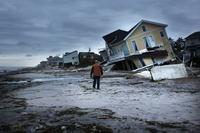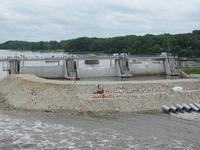-
Reducing the impact of extreme weather
How do we reduce the impact of extreme weather today while preparing ourselves for future changes? What can we do to build our resilience? A new report from the Royal Society investigates these, and other, key questions to help inform important decisions about adaptation and risk reduction that are being made at global, national and local levels.
-
-
New report highlights “significant and increasing” risks from extreme weather

A comprehensive new report, published by the Royal Society, indicates that exposure of human populations to extreme weather is set to increase as global climate and population size, location, and age continue to change. The report focuses on the risks to people from floods, droughts, and heatwaves. These are some of the most frequent and damaging extreme events that currently occur and their impacts will change with the changing climate. The report also calls for changes to global financial accounting and regulation to ensure that extreme weather risk is made explicit. At present, these risks are not systematically factored into investors’ valuations or assessed by creditors.
-
-
Lights out: Experts say instability of world’s power supplies must be urgently addressed
A new study reveals the urgent need to address instabilities in the supply of electrical power to counteract an increase in the frequency and severity of urban blackouts. The work builds on previous studies which examined a sharp increase in electrical usage over recent years, and warned the world to prepare for the prospect of coping without electricity as instances of complete power failure become increasingly common.
-
-
Many victims of Hurricane Sandy are still waiting for government aid

It has been two years since Hurricane Sandy destroyed thousands of homes and businesses along the Jersey Shore yet many affected homeowners are still waiting for federal and state aid to rebuild. Of the $3.26 billion the U.S. Department of Housing and Urban Development (HUD) has provided to New Jersey, only $802 million has been paid out as of 30 September. The federal government’s first allocation of Sandy funds to New Jersey came seven months after the storm. The state has yet to issue any of the $1.46 billion approved by HUD in May, and New Jersey officials expect a final round of $880 million next spring.
-
-
In worst-case scenario, sea level would rise 1.8 meters
The climate is getting warmer, the ice sheets are melting and sea levels are rising — but how much? The report of the UN’s Intergovernmental Panel on Climate Change (IPCC) in 2013 was based on the best available estimates of future sea levels, but the panel was not able to come up with an upper limit for sea level rise within this century. Now researchers have calculated the risk for a worst-case scenario. The results indicate that at worst, the sea level would rise a maximum of 1.8 meters – but the much more likely rise in sea level would be around 80 cm.
-
-
Bay Area’s infrastructure more resilient, but a major tremor would paralyze region’s economy
Twenty-five years ago, the San Francisco Bay Area suffered the 6.9 magnitude Loma Prieta earthquake, which killed sixty-three people, injured 3,700, destroyed 366 businesses and 11,000 homes, and caused $6 billion in property damage. Since then, bridges and roads have been rebuilt to withstand more powerful quakes, but seismic safety experts say more could be done to protect property and human life. A major earthquake is not likely completely to destroy the Golden Gate Bridge or other major infrastructure developments, but the Bay Area’s $535 billion a year economy will come to a halt for months and even years due to weakened critical infrastructure.
-
-
15 years from now, our impact on regional sea level will be clear

Coastal communities and industries require information on regional sea-level change to develop strategies for reducing the risk to population, infrastructure and the environment. This requires modeling projections of sea-level rise, estimating the costs and benefits of adaptation options, and understanding the impacts on coastal ecosystems. Inundation maps that can be used to identify areas that are most vulnerable to rising sea levels are particularly valuable. Adaptation measures may include land-use planning such as preventing building in low lying areas, increasing or maintaining a vegetated coastal margin that serves as a buffer zone against extreme sea levels, or using protective sea walls in the long run if certain sea level rise thresholds are exceeded.
-
-
Some states are better prepared than others for climate change challenges
In recent years, a number of states have started taking action to prepare their communities for climate change. Many have even developed specific adaptation plans to guide their work. Until now, though, no one has been able to define how much progress states are actually making in implementing those plans. The Georgetown Climate Center’s (GCC) online tool, the State Adaptation Progress Tracker, changes that. A GCC release says that now, anyone will be able to quickly determine how much progress their state is making and decision-makers will be able to learn from innovative examples of actions other states are taking.
-
-
As sea level rises, coastal communities brace for more frequent, destructive tidal flooding
Today, many coastal communities are seeing more frequent flooding during high tides. As sea level rises higher over the next fifteen to thirty years, tidal flooding is expected to occur more often, cause more disruption, and even render some areas unusable — all within the time frame of a typical home mortgage. An analysis of fifty-two tide gauges in communities stretching from Portland, Maine to Freeport, Texas shows that most of these communities will experience a steep increase in the number and severity of tidal flooding events over the coming decades, with significant implications for property, infrastructure, and daily life in affected areas. The report warns that given the substantial and nearly ubiquitous rise in the frequency of floods at these fifty-two locations, many other communities along the East and Gulf Coasts will need to brace for similar changes.
-
-
Blackout? Robots can help
Big disasters almost always result in big power failures. Not only do they take down the TV and fridge, they also wreak havoc with key infrastructure like cell towers. That can delay search and rescue operations at a time when minutes count. Now, researchers have developed a tabletop model of a robot team that can bring power to places that need it the most. In addition to disaster recovery, their autonomous power distribution system could have military uses, particularly for Special Forces on covert missions.
-
-
New report identifies populations most vulnerable to extreme weather events
Extreme weather events leave populations with not enough food both in the short- and the long-term. A new report has looked at which sections of the population are left most exposed to food shortages after extreme weather events, and concluded that better governance could have lessened the impact on the poorest and most vulnerable, and that affected populations have been let down by the authorities in the past.
-
-
New Orleans creates economic value out of environmental vulnerability
Following the devastation of Hurricane Katrina in 2005, New Orleans and the state of Louisiana have become so adept at dealing with disaster reconstruction, that their new-found skills are now seen as an economic asset to be shared, for profit, with other states and localities. The area’s new environmental awareness is also a source of economic growth, as analysts now consider “emerging environmental” as one of six key industries in the city and state to focus on development, along with coastal restoration and water management, disaster mitigation and management, hazardous waste disposal, advanced bio fuels and waste water treatment.
-
-
Assessing the damage of runaway barges at the Illinois River lock and dam

It takes a synchronized lock and dam system — operating like a motorized flight of stairs on the Illinois River, using gravity to move the water — to maintain a minimum depth for boat traffic. A disastrous domino effect occurred on 19 April 2013, when heavy rain and runoff, strong winds, and river currents resulted in seven unmoored barges crashing into the dam at Marseilles, Illinois. Researchers say that the system of locks and dams on the Illinois River is vulnerable to changing climate and weather extremes. These more frequent and unpredictable conditions can cause shipping accidents, damage to lock and dam systems, streambank erosion, shipping accidents, and local flooding.
-
-
U.S. Northwest prepares for the Big One
Seismologists believe the Pacific Northwest is overdue for an earthquake that could register at over 8.0 on the Richter scale, leading many emergency management professionals in the region to anticipate and prepare for the devastating impact such an event would have on the local economy. Experts talk about Triple 3 Resilience Target as a the goal for managing the aftermath of an earthquake: have emergency services running within three days; level of services to sustain the economy within three weeks; and a target of three years to stabilize the economy and prepare for future disasters.
-
-
Innovative projects seek emergency housing alternative to FEMA’s trailers

Brownsville, Texas may soon become a model for other hurricane-ravaged cities as community groups institute new emergency housing measures in the wake of inexcusable hold-ups on the part of the Federal Emergency Management Agency (FEMA) in providing reconstruction support to the South Texas coast after $1.35 billion in damage from Hurricane Dolly in 2008.
-
- All
- Regional
- Water
- Biometrics
- Borders/Immig
- Business
- Cybersecurity
- Detection
- Disasters
- Government
- Infrastructure
- International
- Public health
- Public Safety
- Communication interoperabillity
- Emergency services
- Emergency medical services
- Fire
- First response
- IEDs
- Law Enforcement
- Law Enforcement Technology
- Military technology
- Nonlethal weapons
- Nuclear weapons
- Personal protection equipment
- Police
- Notification /alert systems
- Situational awareness
- Weapons systems
- Sci-Tech
- Sector Reports
- Surveillance
- Transportation
Advertising & Marketing: advertise@newswirepubs.com
Editorial: editor@newswirepubs.com
General: info@newswirepubs.com
2010-2011 © News Wire Publications, LLC News Wire Publications, LLC
220 Old Country Road | Suite 200 | Mineola | New York | 11501
Permissions and Policies
Editorial: editor@newswirepubs.com
General: info@newswirepubs.com
2010-2011 © News Wire Publications, LLC News Wire Publications, LLC
220 Old Country Road | Suite 200 | Mineola | New York | 11501
Permissions and Policies
